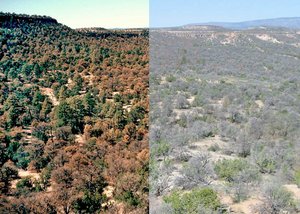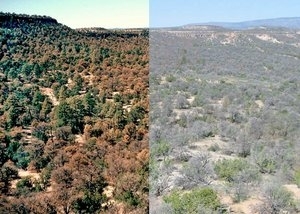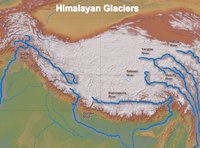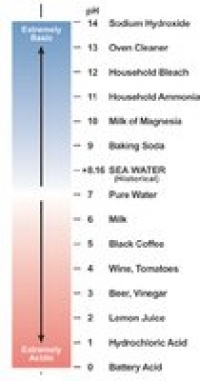Climate Literacy Handbook: Principle 7
| Topics: |
Previous: Principle 6 | Table of Contents (Climate Literacy Handbook: Principle 7) |Next: none
| Principle 7. Climate change will have consequences for the Earth system and human lives |
Essential Principle 7 relates to the current and predicted consequences of climate change. Once primarily the domain of climate scientists, the impacts of climate change on humans and environmental systems has become a focus for resource managers, medical professionals, emergency managers, insurance companies, and military planners.
Appreciating that poverty, a lack of resources and the absence of political will compound existing problems, many feel that the challenge of the 21st century will be in preparing communities to adapt to climate change while reducing human impacts on the climate system (known as mitigation). Many jobs if not entire industries will emerge to address these complex issues.
|
Concept 7a. Melting of ice sheets and glaciers, combined with the thermal expansion of seawater as the oceans warm, is causing sea level to rise. Seawater is beginning to move onto low-lying land and to contaminate coastal fresh water sources and beginning to submerge coastal facilities and barrier islands. Sea-level rise increases the risk of damage to homes and buildings from storm surges such as those that accompany hurricanes. |
Articles in Depth:
Teaching Aids and External Resources:
Using time-lapse cameras to record the melting and retreat of glaciers and ice sheets around the world, the Extreme Ice Survey offers images from around the world. A Google Earth layer is also available.
This six chapter online NOVA program can be used to inform learners about the current research on melting glaciers and icecaps.
These activities, including one using clay and a cornstarch/water mix to model ice sheet growth on a continent, were collected for the launch of the International Polar Year in 2007.
|
Concept 7b. Climate plays an important role in the global distribution of freshwater resources. Changing precipitation patterns and temperature conditions will alter the distribution and availability of freshwater resources, reducing reliable access to water for many people and their crops. Winter snowpack and mountain glaciers that provide water for human use are declining as a result of global warming. |
There are many unknowns in terms of how ecosystems and societies will be impacted by the loss of snow and ice which serve as reservoirs of freshwater. Runoff patterns may shift in many parts of the world with more rain and less snow falling as precipitation. While billions of people depend on runoff from rivers that originate in the Himalayan Glaciers, much of the water in the rivers is from monsoon rains, not snow and ice, so the problem may not be as dire is it might first appear.
Articles in Depth:
Teaching Aids and External Resources:
- Poster: Water and Climate ChangeThis product from The United Nations Environment Programme, can be downloaded and printed. The Freshwater portion of this website also contains publications about freshwater around the globe.
- Lessons: FreshwaterA collection of activities about freshwater from Environment Canada. The site also offers publications that can be obtained free of charge.
- Podcast: As Fresh Water Hits Atlantic, Climate ChangesThis short radio broadcast explains how freshwater runoff is already affecting ocean circulation. From National Public Radio.
- Article: Freshwater Runoff in Arctic (Climate Literacy Handbook: Principle 7) A short press release from the American Geophysical Union describing how researchers compared observational data with model simulations of the global hydrological cycle to see how increased exchange could change the distribution of water on Earth's surface.
|
Concept 7c. Incidents of extreme weather are projected to increase as a result of climate change. Many locations will see a substantial increase in the number of heat waves they experience per year and a likely decrease in episodes of severe cold. Precipitation events are expected to become less frequent but more intense in many areas, and droughts will be more frequent and severe in areas where average precipitation is projected to decrease. |
From the NASA Earth Observatory:
Amongst the highest priorities in Earth science and environmental policy issues confronting society are the potential changes in the Earth's water cycle due to climate change. The science community now generally agrees that the Earth's climate will undergo changes in response to natural variability, including solar variability, and to increasing concentrations of greenhouse gases and aerosols. Furthermore, agreement is widespread that these changes may profoundly affect atmospheric water vapor concentrations, clouds, and precipitation patterns. For example, a warmer climate, directly leading to increased evaporation, may well accelerate the hydrologic cycle, resulting in an increase in the amount of moisture circulating through the atmosphere. Many uncertainties remain, however, as illustrated by the inconsistent results given by current climate models regarding the future distribution of precipitation.
Articles in Depth:
Teaching Aids and External Resources:
- Lessons: Water - Here, There, EverywhereThree inquiry-based classroom activities that explore the potential impact of climate variability and change on Earth's most abundant resource: water. Part of a larger curriculum guide called Potential Consequences of Climate Variability and Change. From the Institute for Global Environmental Strategies.
- Lessons: Climate Change from Pole to Pole
This NSTA publication contains a number of inquiry based climate change investigations, including one where students investigate heat wave related human deaths in different U.S. cities.
|
Concept 7d. The chemistry of ocean water is changed by absorption of carbon dioxide from the atmosphere. Increasing carbon dioxide levels in the atmosphere is causing ocean water to become more acidic, threatening the survival of shell-building marine species and the entire food web of which they are a part. |
From Ocean-Acidification.net:
"Since the beginning of the industrial revolution, the ocean has absorbed approximately 48% of the anthropogenic CO2 released to the atmosphere, significantly reducing its impact on climate. At current "emissions-avoidance" costs of $10-35 US dollars per ton of CO2 emissions avoided, this represents an ecosystem service worth trillions of dollars. However, this valuable service comes at a steep ecological cost - the acidification of the ocean. As CO2 dissolves in seawater, the pH of the water decreases, making it more acidic. Since the beginning of the industrial revolution, ocean pH has dropped globally by 0.12 pH units. While these pH levels are not alarming in themselves, the rate of change is cause for concern…."
The oceans are not, in fact, acidic, but slightly basic. Acidity is measured using the pH scale, where 7.0 is defined as neutral, with higher levels called "basic" and lower levels called "acidic". Historical global mean seawater values are approximately 8.16 on this scale, making them slightly basic. To put this in perspective, pure water has a pH of 7.0 (neutral), whereas household bleach has a pH of 12 (highly basic) and battery acid has a pH of zero (highly acidic).
By the end of this century, if concentrations of CO2 continue to rise at current rates, we may expect to see changes in pH that are three times greater and 100 times faster than those experienced during the transitions from glacial to interglacial periods. Such large changes in ocean pH have probably not been experienced on the planet for the past 21 million years.
However, even a small change in pH may lead to large changes in ocean chemistry and ecosystem functioning. Over the past 300 million years, global mean ocean pH values have probably never been more than 0.6 units lower than today. Ocean ecosystems have thus evolved over time in a very stable pH environment, and it is unknown if they can adapt to such large and rapid changes. Based on the emissions scenarios of the Intergovernmental Panel on Climate Change and general circulation models, we may expect a drop in ocean pH of about 0.4 pH units by the end of this century, and a 60% decrease in the concentration of calcium carbonate, the basic building block for the shells of many marine organisms.
Articles in Depth:
Teaching Aids and External Resources:
A short informative article about ocean acidification. The parent website, Ocean Acidification.net, has additional information at its Frequently Asked Questions features.
An article about ocean acidification from New Scientist, and a link to a podcast with Joanie Kleypas from UCAR.
|
Concept 7e. Ecosystems on land and in the ocean have been and will continue to be disturbed by climate change. Animals, plants, bacteria, and viruses will migrate to new areas with favorable climate conditions. Infectious diseases and certain species will be able to invade areas that they did not previously inhabit. |
 These photos show the massive die-off of piñon pines that occurred during the recent drought. By October 2002, piñons, normally evergreen, had reddish-brown foliage (left). By May 2004, the dead piñons had lost all their needles, exposing their gray trunks. The photos were taken from the same vantage point in the Jemez Mountains near Los Alamos. Credit: Photo courtesy of Craig D. Allen, U.S. Geological Survey. From Los Alamos National Laboratory: http://www.ees.lanl.gov/news/archive_oct_dec_2005.shtml
These photos show the massive die-off of piñon pines that occurred during the recent drought. By October 2002, piñons, normally evergreen, had reddish-brown foliage (left). By May 2004, the dead piñons had lost all their needles, exposing their gray trunks. The photos were taken from the same vantage point in the Jemez Mountains near Los Alamos. Credit: Photo courtesy of Craig D. Allen, U.S. Geological Survey. From Los Alamos National Laboratory: http://www.ees.lanl.gov/news/archive_oct_dec_2005.shtml In recent years, millions of pinyon pine trees in the American Southwest have died due to drought and high heat. Global climate models predict persistent drought for the American Southwest under current rates of change.
Articles in Depth:
Teaching Aids and External Resources:
- Article: Underlying Cause of Massive Pinyon Pine Die-Off Revealed (Climate Literacy Handbook: Principle 7) A short article describing research related to the pinyon pine die-off.
- Essays: Bering ClimateThe Bering Sea is intensively studied and multiple measurements indicate changes. These essays provide insight into the changing ecosystem. Additional links on the website can be used to access graphics and raw data about the area.
- Article: Geo-Ecological Study of...the Hopi Buttes area, Navajo Nation, Arizona (Climate Literacy Handbook: Principle 7) An article describing a current U.S. Geological Survey project documenting climate variability and land use impacts through measurements and native accounts.
|
Concept 7f. Human health and mortality rates will be affected to different degrees in specific regions of the world as a result of climate change. Although cold-related deaths are predicted to decrease, other risks are predicted to rise. The incidence and geographical range of climate-sensitive infectious diseases—such as malaria, dengue fever, and tick-borne diseases—will increase. Drought-reduced crop yields, degraded air and water quality, and increased hazards in coastal and low-lying areas will contribute to unhealthy conditions, particularly for the most vulnerable populations. |
The wide range of climate-related challenges facing every community are enormous and may appear at times to be overwhelming. The U.S. and other militaries around the world recognize climate change as a serious, potentially catastrophic national and global security threat.
Being aware of the complex, diverse issues is the first step toward building robust, resilient communities and protecting ecosystems. Recently, the Preventive Medicine community, which has years of communicating “bad news” about health and environmental risks to relevant organizations and agencies, began to tackle the health impacts of climate change with a special issue of the American Journal of Preventive Medicine. One article is titled “Community-Based Adaptation to the Health Impacts of Climate Change” by Kristie Ebi and Jan Semenza. Their abstract reads:
The effects of and responses to the health impacts of climate change will affect individuals, communities, and societies. Effectively preparing for and responding to current and projected climate change requires ongoing assessment and action, not a one-time assessment of risks and interventions. To promote resilience to climate change and other community stressors, a stepwise course of action is proposed for community-based adaptation that engages stakeholders in a proactive problem solving process to enhance social capital across local and national levels. In addition to grassroots actions undertaken at the community level, reducing vulnerability to current and projected climate change will require top-down interventions implemented by public health organizations and agencies.
Articles in Depth:
Teaching Aids and External Resources:
- Lesson: Human Health - Beyond the Bite: Mosquitoes and MalariaAn inquiry-based activity exploring one potential impact of climate variability and change on our health: the increased spread of malaria. Part of a larger curriculum guide called Potential Consequences of Climate Variability and Change. From the Institute for Global Environmental Strategies.
- Report: National Security and the Threat of Global Climate ChangeA report exploring potential security threats raised by continued climate change impacts, from the CNA corporation.
- Podcasts: Preventive Medicine and Climate ChangePodcasts discussing the Ebi and Semenza article quoted above, among others from the special issue.
- Podcast: Global Changes, Global HealthA short radio broadcast highlighting the work of Jonathan Patz, who argues that insects that transimit disease pathogens might find a lot of advantage in changes to the global climate. From Earthwatch Radio.
|
|


